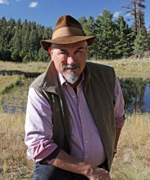—Alan Dulaney
 Hear that? The clink of chips, the soft shuffle of cards on the table? It’s the sound of a Colorado River deal unraveling.
Hear that? The clink of chips, the soft shuffle of cards on the table? It’s the sound of a Colorado River deal unraveling.
Recall that the tiered shortage levels set up in 2007 are tied to falling water level elevations in Lake Mead. At 1075 feet, the first shortage is declared, and Arizona is cut 320,000 acre-feet of excess and agricultural water, all from the CAP canal. More cuts come at 1050 feet and 1025 feet, wiping out the agricultural pool — but below that point nothing is clear. California never takes a cut under these criteria. The drought and structural deficit in the Lower Basin mean that those levels cannot be avoided; Lake Mead declines are inexorable. That was the rationale behind negotiations between Arizona, California, Nevada, and Reclamation on the Drought Contingency Plan (DCP).
In December, the Colorado River Water Users Association met in Las Vegas. It was hoped for many months that the imminent finalization of the DCP would be announced and Lake Mead would be stabilized. But California and Arizona could not cobble together the needed internal consensus, and all now realize that no deal will occur prior to January 20.
In California, it’s the old north-versus-south divide. Northern California wants surety for the Sacramento-San Joaquin Delta and its endangered species, in the face of increasing water demands from Los Angeles and San Diego. Transfers of water from north to south touch many nerves amongst larger users in northern California. To the south, Metro Water can’t do without both north-to-south transfers and the Colorado Aqueduct, but they don’t hold the trump cards. Imperial Irrigation District possesses the largest allocation of Colorado River water — over 3 million acre-feet. But before agreeing to any shortage, IID wants something done about the Salton Sea, which is drying up and thus allowing contaminant particles to become airborne. Adverse impacts are showing up in human populations. The health risks are real. So are the risks to the DCP, because lacking substantive resolution of these major environmental issues, California won’t sign any deal.
Arizona doesn’t have it together either. ADWR quietly put together a plan to go even further than DCP, called “DCP Plus.” Under DCP Plus, Arizona would have left 1.2 million acre-feet on Lake Mead over 3 years by foregoing existing water demand. Water-level elevations would have been stabilized above 1,075 feet, and no shortage would have been declared. The deal depended on both compensated and uncompensated system conservation, and most of the water would have come from tribal entities. Compensation would require $61.5M over 3 years, some from the state, some from cities, and most of it from the Federal government. CAWCD would have committed all excess water to remain on Lake Mead. Three years would have bought time to negotiate solutions to ongoing problems and allow agriculture and other sectors to adapt to shrinking deliveries of CAP water. And signing DCP Plus would have given Arizona a united front for DCP talks.
Then the cards went south. The goal was to finalize DCP Plus by the end of 2016. The cities were generally in favor of the concept, but budgets were already set and allowed no room for extra expenses, nor was sufficient time built in to gain Council approvals. The agricultural sector was warming to the concept of 3 extra years but not to the amount of water they would forego. The tribes were generally supportive but disapproved of the “asks” from other sectors. Since everything hinged on the Federal funding, which would not be forthcoming without commitments, it was clear by mid-December that DCP Plus would not be final prior to January 20.
Last Thursday at the CAWCD Board of Directors meeting, the idea was broached publicly that CAWCD should retain control of excess CAP water beyond a set amount for delivery to lower priority users. The Cities (subcontract holders) objected to CAWCD holding back some excess water for users such as CAGRD (no subcontract). The implication: Cities won’t commit to DCP Plus if CAWCD won’t commit to leaving all excess water on Lake Mead; without City funding commitments, the Feds won’t contribute the majority of the money; and without the money for compensated system conservation, nothing will happen. No DCP Plus means no DCP. Hence the unraveling.
And there is Mexico. Minute 319 of the international water treaty runs out at the end of 2017, and Mexico and the U.S. are negotiating Minute 32x to replace it. Mexico seems agreeable to leaving water on Lake Mead, and a draft agreement is close. But so is January 20.
At CRWUA, the outgoing Secretary of the Interior noted — several times — that probabilities exceed 50% that a shortage will be declared on the Colorado River in 2018. Without the DCP to stabilize Lake Mead, Arizona will be launched on the slippery slope of the 2007 guidelines. If the new Secretary steps in to redistribute deliveries amongst the states, Arizona could well take the biggest hit. That is not a winning hand. There is still time before August (when the shortage would be declared) to resolve differences within Arizona and finalize DCP Plus, and gain 3 more years. With a stable Lake Mead, CAP deliveries can continue, to the economic benefit of Arizona. ADWR retains hope of success, but the hour is growing late.